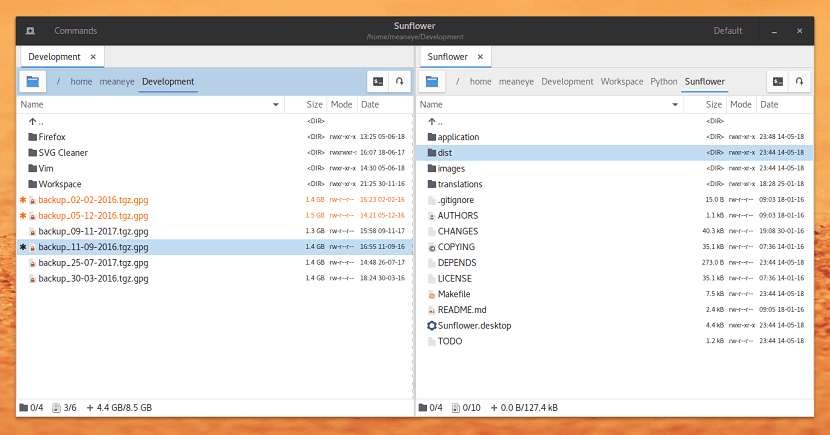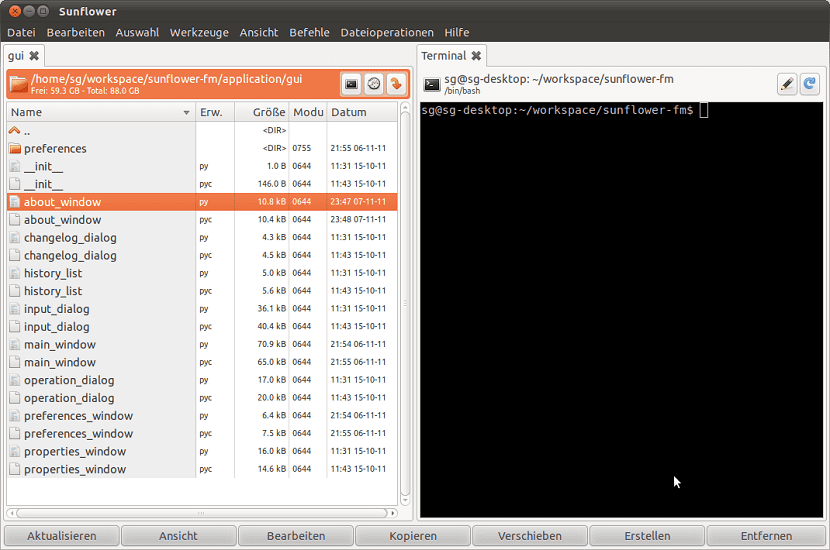
Sunflower is a highly configurable, powerful, and easy-to-use two-pane file manager built for Linux with plugin support. It works with all desktop environments like Gnome, Unity, KDE, Lxde, Xfce, Cinnamon, Mate, and others.
Sunflower is open source and developed using the Python language, it is currently in active development and releasing stable versions. Sunflower offers two windows that implement an unusual concept when trying to integrate the command line with the file manager.
About the Sunflower file manager
Bookmarks can be added and edited from the options menu. Similarly, the simple startup option allows you to go to the home directory.
Sunflower can be very useful for accessing documents in two panels side by side, for easy comparison of required documents from separate directories.
This is much easier than opening two overlapping windows to compare files and folders.
For example, one may wish to organize images in a separate folder in the Home directory, while images may be scattered around the Downloads directory.
In such a case, one can easily manage the images by opening the Downloads folder on one panel and the Home folder on the other.
How to install Sunflower on the different Linux distributions?
Sunflower is an application that has begun to gain popularity so it can be found within the repositories of some Linux distributions and in others it will have to be integrated into the system.
If they are Ubuntu, Linux Mint and derivatives users can obtain this application by adding its repository to our system:
The only thing we will have to do is open a terminal in the system with Ctrl + Alt + T and in it type the following commands:
sudo add-apt-repository ppa:atareao/sunflower sudo apt-get update sudo apt-get install sunflower
Another method to install this file manager on both Debian and Ubuntu and derivatives is downloading the latest stable deb package from its official website. The link is East.

The package We download it with the help of the wget command as follows:
wget http://sunflower-fm.org/pub/sunflower-0.3.61-1.all.deb
Download now we are going to perform the installation with our favorite package manager or from the same terminal with:
sudo dpkg -i sunflower-0.3.61-1.all.deb
And we solve the dependencies with:
sudo apt -f install
Those who use Arch Linux, Manjaro Linux, Antergos or any other derivative of Arch Linux You can install this application from the AUR repositories. Only they must have the AUR repository enabled and an AUR wizard installed.
If you don't have it, you can visit the following article where we explain how to do it.
To install in a terminal we are going to type the following command:
yay -S sunflower
While for those who are users of Fedora, CentOS, RHEL and any derivative of these, we are going to download the stable rpm package from the official website.
In a terminal we type:
wget http://sunflower-fm.org/pub/sunflower-0.3.61-1.noarch.rpm
And we are going to install the downloaded file with:
sudo rpm -i sunflower-0.3.61-1.noarch.rpm
Now for the special case of openSUSE users you should download this package:
wget http://sunflower-fm.org/pub/sunflower-0.3.61-1.noarch.opensuse.rpm
The installation is done with the command:
sudo zypper in sunflower-0.3.61-1.noarch.opensuse.rpm
Finally, for whoever Gentoo users install this administrator by executing the following command:
emerge --ask x11-misc/sunflower
Sunflower Basic Usage
Sunflower's control concept is also different from its competitors as the Sunflower file manager makes use of the keyboard.
These are some of its shortcuts:
- CTRL + A: Select all files
- * on the numeric keypad: Invert selection
- + numeric keypad: Select with pattern
- - Numeric keyboard Deselect with pattern
- ALT + (+ numeric keypad) Select items with the same extension
- ALT + (- numeric keypad) Deselect items with the same extension
- CTRL + F1 Show markers / montages for left panel
- CTRL + F2 Show markers / montages for the right pane
- Options window CTRL + ALT + P
- CTRL + H show hidden files
- CTRL + Q Exit the application
- F11 Full screen
- F12 Compare directories
It seems to me the "mc" but graphically. In any case it seems an interesting alternative to the serial manager.